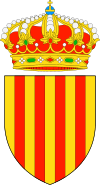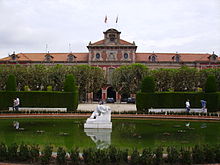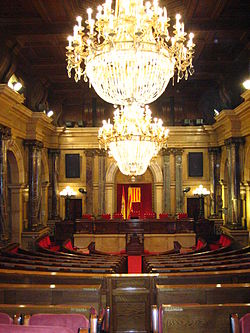- Parliament of Catalonia
-
Parliament of Catalonia
Parlament de Catalunya9th Legislature 
Type Type Unicameral Leadership President Núria de Gispert i Català, UDC
since December 16, 2010Vice Presidents Lluís Maria Corominas i Díaz (CDC)
Higini Clotas i Cierco (PSC)
since December 16, 2010Secretaries Jordi Cornet i Serra (PPC)
Montserrat Tura i Camafreita (PSC)
Josep Rull i Andreu (CDC)
Dolors Batalla i Nogués (CDC)
since December 16, 2010Structure Members 135 
Political groups CiU (62)
PSC (28)
PPC (18)
ICV – EUiA (10)
ERC (10)
C’s (3)
SI (3)
Unattached (1)Committees 22- Institutional Affairs
- Economy, Finances and Budgets
- Enterprise and Employment
- Justice
- Home Affairs
- Agriculture, Livestock, Fisheries, Food and Environment
- Education and Universities
- Country Planning and Sustainability
- Social Welfare, Family and Immigration
- Culture and Language
- Health
- Procedure
- Member's Rules
- Petitions
- Secret Affairs
- Ombudsman
- Public Audit
- Control of the Catalan Corporation of Public Media
- People's Equality
- Youth
- Foreign Affairs and European Union
- Cooperation and Solidarity
Elections Last election November 28, 2010 Meeting place Palau del Parlament de Catalunya, Parc de la Ciutadella, Barcelona Website www.parlament.cat Catalonia 
This article is part of the series:
Politics and government of
CataloniaStatuteParliamentJudiciaryPublic orderElectionsDivisions
Other countries · Atlas
Politics portal
The most recent parliamentary elections were held on November 28, 2010. The Centre-Left coalition Government, made up of Socialists' Party of Catalonia (PSC), Republican Left of Catalonia (ERC) and Initiative for Catalonia Greens (ICV), lost 22 seats, while the Centre-Right parties, Convergence and Union (CiU) and People's Party (PPC), gained a combined 18 seats. CiU now controls 62 of 135 seats, more than twice what any other party holds, but they have yet to negotiate a coalition deal to reach a 68 seat majority.
Also, Catalan Solidarity for Independence (SI), which is a new 2010 electoral coalition of six Catalan independentist minor parties, entered parliament for the first time. They elected 4 deputies to the chamber, making them the 6th largest party.
Contents
History
The first representative and legislative bodies in Catalonia were the Sanctuary and Truce Assemblies (assemblees de pau i treva), of which the earliest record dates from 1027. These were originally ad hoc, local meetings convened by the Church—Oliba, Bishop of Vic (died 1046) was a notable instigator—but progressively became subsumed into the court of the Counts of Barcelona. The first Catalan legal code, the Usatges de Barcelona, was promulgated by Count Ramon Berenguer I based on the decisions of these Assemblies.
Although the Counts of Barcelona, Kings of Aragón from 1137, had greatly extended the territory under their control, their financial and military power was quite limited, partly because of their former status as vassals of the Carolingian dynasty. Their personal resources were particularly insufficient in periods of economic crisis or military expansion, of which they were many from the twelfth to the fifteenth centuries. The need to secure troops and revenue led to the steady expansion of the royal court and a formalisation of its procedures. It came to be referred to as the Corts general de Catalunya or Corts catalanes, and was endowed with formal procedures—effectively a written constitution—by King Peter III of Aragon in 1283.
The Corts catalanes were composed of three estates (tres braços), representing the Church, the feudal nobles and the citizens of Royal towns such as Barcelona or Girona. Inhabitants of feudal towns (e.g. Cardona) were not represented, except by their overlords. The main function of the Corts was legislative, either in approving laws proposed by the King (constitucions) or at their own initiative (capítols de cort). Although the Corts met at irregular intervals—as often as the Crown needed to find new resources—they also formally approved the acts of the King between their sessions (known as pragmàtiques) and, from 1359, established a permanent delegation to oversee the Crown (forerunner of the Generalitat de Catalunya). The Corts catalanes were abolished by the Nueva Planta decrees in 1715.
There were several attempts in the early twentieth century to institute an autonomous system of representation for Catalonia. The Commonwealth of Catalonia (1914–25) was an assembly of the provincial delegations of Barcelona, Girona, Lleida and Tarragona, abolished by Primo de Rivera. After an abortive declaration of a Catalan Republic in 1931, a separate Parliament of Catalonia was established under the first Statute of Autonomy and elected in 1932. This Parliament was suspended between 1934 and 1936, and abolished by Francisco Franco in 1938. The first legislature of the current Parliament of Catalonia was elected in 1980.
Functions
- To elect the President of the Generalitat de Catalunya.
- To pass the Catalan legislation in the business of its competence.
- To pass the Budget of the Autonomous Community of Catalonia.
- To control the action of the Government of Catalonia and the autonomous agencies, public companies and all other bodies answerable to it.
References
- "Parlament de Catalunya – Història" (in Catalan). http://www.parlament-cat.net/pls/portal/url/page/pcat/IE1/IE12. Retrieved January 5, 2007.
External links
- Official website (multilingual, mostly in Catalan)
Politics of Catalonia Parliament of Catalonia series President Board Plenary Assembly Groups Barcelona landmarks Buildings and
interesting places:Arc de Triomf · Avinguda Diagonal · Barcelona Pavilion · Bellesguard · Biblioteca de Catalunya · Casa Amatller · Casa Batlló · Casa Calvet · Casa de l'Ardiaca · Casa Fuster · Casa Lleó-Morera · Casa Milà · Casa Terrades · Casa Vicens · Castell dels Tres Dragons · Cathedral of Santa Eulalia · Columbus Monument · Dona i Ocell · Drassanes Reials · Els Quatre Gats · Estació de França · Fabra Observatory · Font de Canaletes · Forum Building · Fossar de les Moreres · Fundació Joan Miró · Hospital de Sant Pau · Hospital de Sant Pau · Hotel Arts · Hotel Habitat Sky · IMAX Barcelona · Jewish quarter · Jonqueres Monastery · La Boqueria · L'Auditori · L'Illa · Magic Fountain of Montjuïc · Mercat del Born · Mercat de Sant Antoni · Montjuïc Castle · Montjuïc Communications Tower · Olympic Harbour · Olympic Ring of Barcelona · Palau del Baró de Quadras · Palau Episcopal de Barcelona · Palau Güell · Palau de la Generalitat de Catalunya · Palau Reial Major · Palau Robert · Palau de la Virreina · Parliament of Catalonia · Pedralbes Monastery · Poble Espanyol · Sagrada Família · Sagrat Cor · Sala de les Cent Columnes · Santa Maria del Mar · Santa Maria del Pi · Torre Agbar · Torre de Collserola · Vapor Vell · World Trade Center Barcelona
Streets and squares: Avinguda Diagonal · Carrer d'Avinyó · Carrer Ferran · Carrer Tallers · Gran Via de les Corts Catalanes · La Rambla · Passeig de Gràcia · Plaça de Catalunya · Plaça d'Espanya · Plaça Reial · Plaça Sant Jaume · Plaça de Sant Felip Neri · Rambla de CatalunyaMuseums: Archaeology Museum of Catalonia · Caixafòrum · CCCB · CosmoCaixa Barcelona · Fundació Antoni Tàpies · Gracia Arts Project · Institut Botànic de Barcelona · Jardí Botànic · MACBA · Museu de les Arts Decoratives · Museu Castell de Montjuïc & Museu Militar · Wax museum · Museu de Ceràmica · Museu de la Ciència · Egyptian Museum · Museu de l'Eròtica de Barcelona · Museu Etnològic · Museu Frederic Marès · Museu d'Història de Catalunya · Museu d'Història de la Ciutat · Maritime Museum · Museu del Modernisme Català · Museu de la Música · Museu Nacional d'Art de Catalunya · Museu del Perfum de Barcelona · Museu Picasso · Museu Tèxtil i d'Indumentària · Museu de la XocolataSports: Camp Municipal Narcís Sala · Camp Nou · Camp de Les Corts · Estadi de Sarrià · Estadi Olímpic Lluís Companys · Mini Estadi · Palau dels Esports · Palau Blaugrana · Palau Sant JordiPerforming arts: Gran Teatre del Liceu · L'Auditori · Palau de la Música Catalana · Teatre Apolo · Teatre Grec · Teatre Lliure · Teatre Poliorama · Teatre RomeaParks: Laberint d'Horta · Parc de les Aigües · Parc de la Ciutadella · Parc de Diagonal Mar · Parc de l'Espanya Industrial · Park Güell · Parc de la Creueta del Coll · Parc Joan Miró · MontjuïcZoos: Aquarium Barcelona · Parc Zoològic de BarcelonaBeaches: Barceloneta beach · Bogatell beach · Mar Bella beach · Nova Icària beach · Nova Mar Bella beach · Sant Sebastià beachCoordinates: 41°23′17″N 2°11′20″E / 41.38806°N 2.18889°E
Categories:- Parliament of Catalonia
- Politics of Catalonia
- Legislatures of the Spanish Autonomous Communities
- Unicameral legislatures
Wikimedia Foundation. 2010.
Look at other dictionaries:
Parliamentary groups of the Parliament of Catalonia — The parliamentary groups of the Parliament of Catalonia(Catalan: grups parlamentaris ) are groups of deputies in the Parliament of Catalonia organized by political party or by coalition of parties. Their function is both political and… … Wikipedia
Plenary Assembly of the Parliament of Catalonia — The plenary assembly of the Parliament of Catalonia ( ca. Ple del Parlament) is the highest body of the Parliament of Catalonia, competent to decide any question within the remit of the Parliament as governed by the Statute of Autonomy of… … Wikipedia
Board of the Parliament of Catalonia — The Board of the Parliament of Catalonia ( ca. Mesa del Parlament) is the body responsible for the management of the Parliament of Catalonia. It is composed of the President of the Parliament, the two Vice Presidents of the Parliament and four… … Wikipedia
List of Presidents of the Parliament of Catalonia — External links* [http://www.parlament cat.net/ Official site of the Parlament of CataloniaExternal links* [http://www.parlament cat.net/ Official site of the Parlament of Catalonia … Wikipedia
Catalonia — For other uses, see Catalonia (disambiguation) and Catalunya (disambiguation). Catalonia Catalunya (Catalan) Cataluña (Spanish) Catalonha … Wikipedia
Plenary Assembly of the Seventh legislature of the Parliament of Catalonia — … Wikipedia
Parliamentary groups of the Seventh legislature of the Parliament of Catalonia — CiU Parliamentary Group= PresidentArtur Mas i GavarróEntered: December 16 2003 (BOPC, 3)pokespersonFelip Puig i GodesEntered: December 16 2003 (BOPC, 3)Assistant spokespersonJosep Maria Pelegrí i AixutEntered: December 16 2003 (BOPC,… … Wikipedia
Board of the Eighth legislature of the Parliament of Catalonia — The composition of the Board of the Eighth legislature was published in the Butlletí Oficial del Parlament de Catalunya on 2006 11 17 … Wikipedia
Plenary Assembly of the Eighth legislature of the Parliament of Catalonia — … Wikipedia
Parliamentary groups of the Eighth legislature of the Parliament of Catalonia — … Wikipedia


